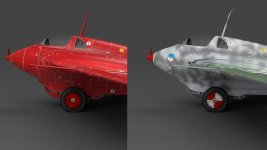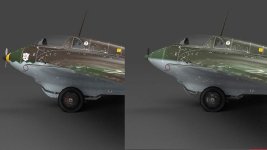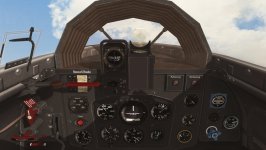gecko
Charter Member
Yep, she is fast, and is still fairly maneuverable at high speeds. I've had a great time working on the flight dynamics for this aircraft. I seriously question any source that claims it broke the sound barrier though. I watched an interview with Rudy Opitz, one of the chief test pilots, and also the pilot of the aircraft involved in the incident you described, and he denied speculation that his aircraft or any other Me 163 ever broke the sound barrier. It was, however, one of the first aircraft to enter the transonic flight regime, which it would reach at about Mach .84 and exhibit the nasty characteristic of a strong nose down pitch simultaneous with the controls becoming totally ineffective. The only way out was to throttle back or shut down (if the engine didn't quit on its own due to the negative g forces) before you became the world's fastest lawn dart.
The CFS3 Komet replicates this behavior, minus the negative g engine cutout. At higher altitudes you are more susceptible to this as the speed of sound is lower. You'll have to fly like the real pilots did and use all that excess thrust to climb and then dive back down at idle or once your fuel is exhausted.
I will be including a document that summarizes what I've learned about the Me 163 to give players a better idea of what an amazing and unique machine they are flying.
Andy, just had a closer look at that tail wheel picture and got a new clue for ground handling. I knew the Komet had a castoring tail wheel, but couldn't find out if there was a tail wheel lock. From the stencil painted above it, it seems there was, and it was set by the ground crew before takeoff. So for our purposes, the tail wheel will always be non castoring with no option to unlock it. Thanks!
The CFS3 Komet replicates this behavior, minus the negative g engine cutout. At higher altitudes you are more susceptible to this as the speed of sound is lower. You'll have to fly like the real pilots did and use all that excess thrust to climb and then dive back down at idle or once your fuel is exhausted.
I will be including a document that summarizes what I've learned about the Me 163 to give players a better idea of what an amazing and unique machine they are flying.
Andy, just had a closer look at that tail wheel picture and got a new clue for ground handling. I knew the Komet had a castoring tail wheel, but couldn't find out if there was a tail wheel lock. From the stencil painted above it, it seems there was, and it was set by the ground crew before takeoff. So for our purposes, the tail wheel will always be non castoring with no option to unlock it. Thanks!






